
Proud of our people! Alexey Shchusev: from Orthodox churches to Lenin's Mausoleum
/ Главная / Russkiy Mir Foundation / Publications / Proud of our people! Alexey Shchusev: from Orthodox churches to Lenin's MausoleumProud of our people! Alexey Shchusev: from Orthodox churches to Lenin's Mausoleum
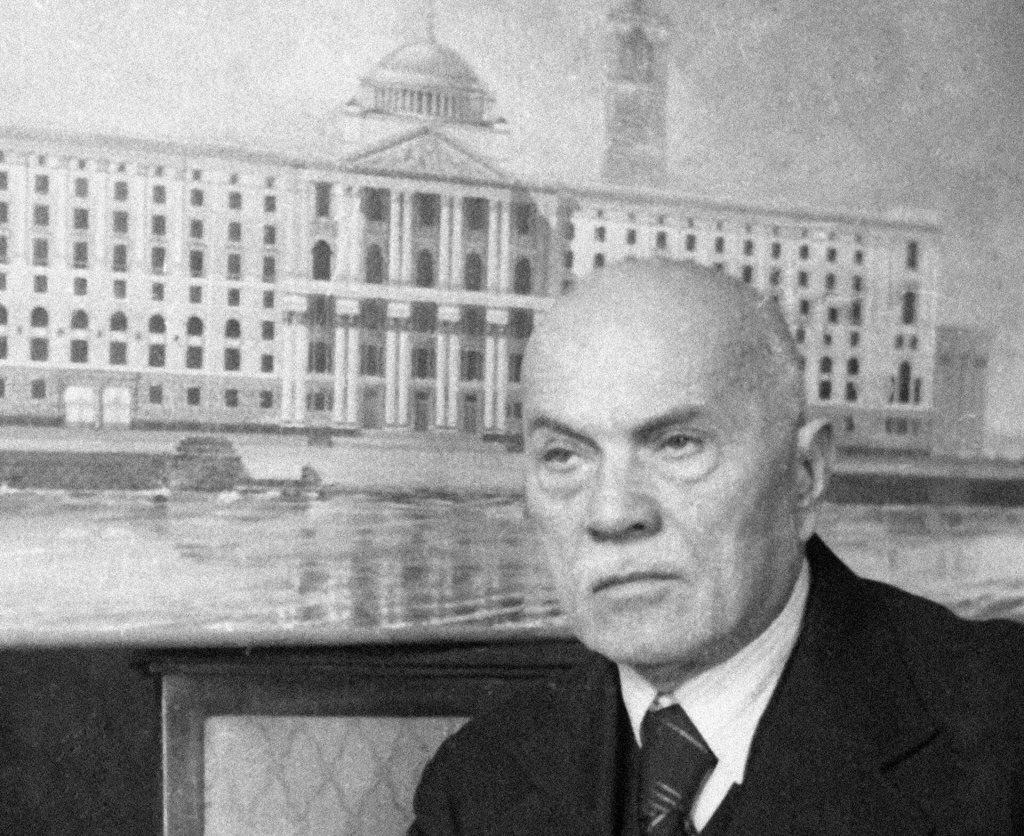
Alexey Shchusev. Photo credit: stylishbag.ru
October, 8 marks the 150th birthday of Alexey Shchusev. He was probably the best-known architect of the Soviet era and designed many of its landmarks, including Lenin's Mausoleum and the Moscow Hotel, as well as the Lubyanka Building (the NKVD headquarters). His fate was unique as his talent was in demand both in tsarist Russia and in the USSR. He was honored with the country's highest awards by Emperor Nicholas II and Soviet leader Joseph Stalin.
Orphan from Chisinau
Alexey Shchusev was born in Chisinau on September 26 (October 8, N.S.), 1873. His father was a retired Zemstvo official and had many children. Alexey had three brothers and a half-sister from his father's former marriage. His parents suddenly passed away. It happened almost on the same day. At that time, Alexey was 15 years old only. However, the young man had a clear understanding of what he wanted to be. He copied reproductions from magazines, sketched out photographs, practiced painting, and studied architectural monuments.
Having finished grammar school, Alexey Shchusev joined the Higher Art School of the Imperial Academy of Arts in St. Petersburg. The Chisinau Zemstvo paid the talented student a scholarship of 300 rubles a year. He used this money for his living. Alexey could not make up his mind between painting and architecture for the first three years. He attended the lessons of architect Grigory Kotov, as well as the classes of such artists as Ilya Repin and Arkhip Kuindzhi. Finally, architecture won.
He used to live half-starving because his scholarship was hardly enough. Nevertheless, the young architect was not discouraged and even sought to find orders of his own. Thus, in 1895, he read the news about the death of General Pozdeev-Shubin and sketched the chapel tombstone right away. Having finished the design, he went to the general's widow and managed to persuade her to entrust the task to the young unknown architect.
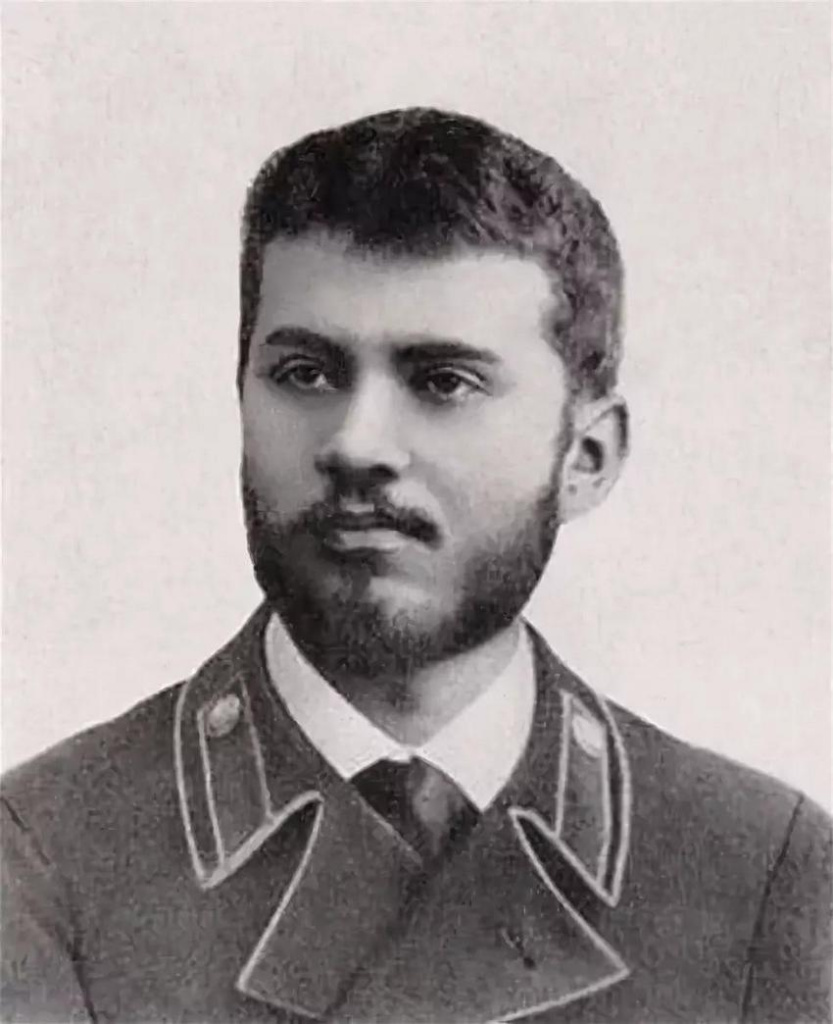
Photo credit: rataku.com
Meanwhile, the young professional explored the architecture of Central Asia by visiting Samarkand as a member of an archaeological expedition. Mr. Shchusev surveyed the oldest monuments of Asian architecture, such as Tamerlane's tomb and the cathedral mosque. He also made tracings of numerous ornaments. The expedition aimed at studying the ancient Russian temples of Rostov, Kostroma, and Yaroslavl also impressed him deeply.
In 1897, the young architect successfully defended his diploma at the Academy of Arts. As a result, he was awarded a grant to travel abroad. Over 16 months of his tour, Mr. Shchusev and his young wife visited Vienna, Paris, Italian cities, and Tunisia. He attended a private academy of arts in Paris for six months.
Architect of the Holy Synod
Having returned home, the architect understood that no one was actually waiting for him there. He was not hired by the Academy of Arts, and it was almost impossible to start a business without appropriate contacts. The only available option was to work as an assistant to more experienced and well-known architects. Grigory Kotov, his teacher from the Academy, gave the talented student a small order for the Assumption Cathedral of the Kiev Pechersk Lavra.
The clergy noticed the iconostasis restored by Mr. Shchusev, and so did Mikhail Nesterov, a famous Russian painter. Mr. Nesterov took the young architect under his patronage and helped him to get orders from famous philanthropists and clergymen. Alexey Shchusev was fascinated by Old Russian architecture and temple art. He joined the Chancellery of the Holy Synod and became an official church architect.
The early 20th century saw a revival of interest in Old Russian art and cultural roots among educated circles of the Russian Empire. It was expressed in the so-called Russian Revival style. It combined elements of Russian ethnic art and Art Nouveau, which was trendy back then. Banks, government offices, and train stations were built in the Russian Revival style. Alexey Shchusev became one of the most prominent representatives of this style in architecture. According to him, he was inspired by the monumental architecture of the Russian Middle Ages in Pskov and Novgorod.
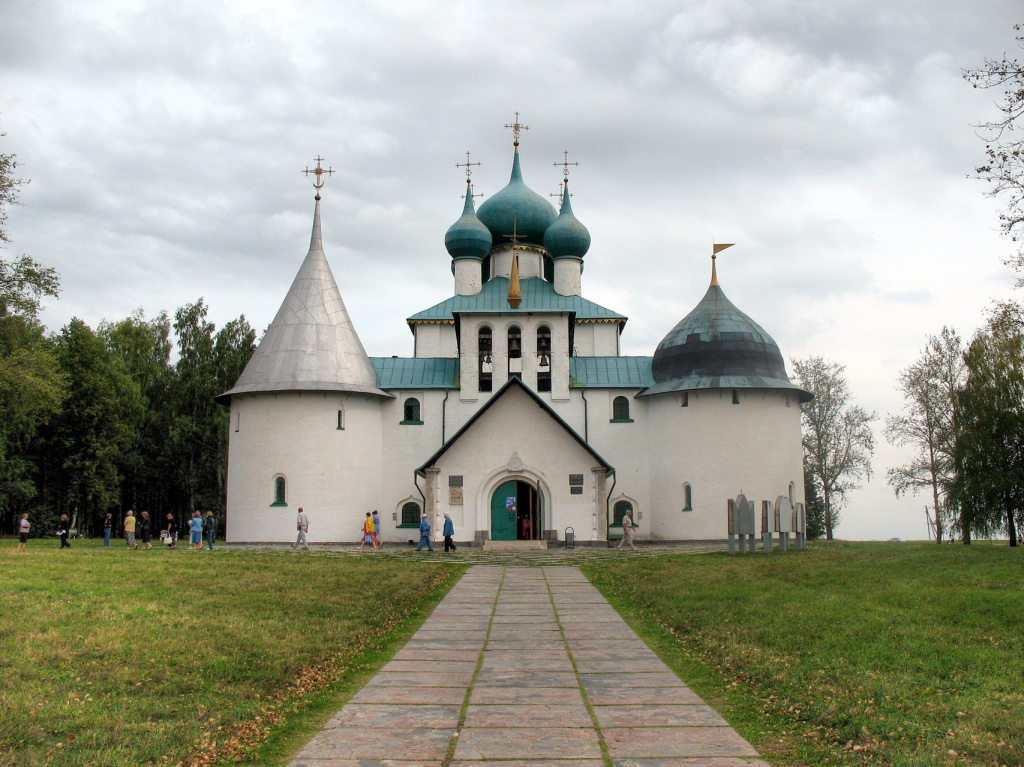
Church of St. Sergius of Radonezh on the Kulikovo Field. Photo credit: Alexxx1979 / wikipedia.org
Mr. Shchusev found his personal artistic style rather quickly. It became evident in his first project of the Church of St. Sergius of Radonezh on the Kulikovo Field. A count from the Olsufievs, a Russian family of great antiquity, came up with the idea for the project. Up to that time, there had been just a memorial column on the Kulikovo Field. Alexey Shchusev designed a very unusual temple with two towers. One of them has a dome that looks like a Russian warrior's helmet. "As for the Kulikovo church, it is coming out very well in terms of architecture. I have changed the upper part of the second tower replacing the dome with a helmet. <...> It's false classics, timid...", - wrote the project's author. At first, the client did not approve of the idea of two towers. However, Mr. Shchusev explained that these were the heroes of the Battle of Kulikovo, Peresvet and Oslyabya. As a result, the original project was approved.
In 1904, the Synod assigned the young architect to restore the 12th-century temple in the ancient town of Ovruch near Zhitomir. The temple was destroyed almost to the ground. Mr. Shchusev addressed the restoration with a scientific approach. He performed a lot of preliminary work, collected all the archaeological artifacts found during the excavations, and then incorporated them into the new temple. The result was an unusual and successful blend featuring elements of ancient construction and modern style.
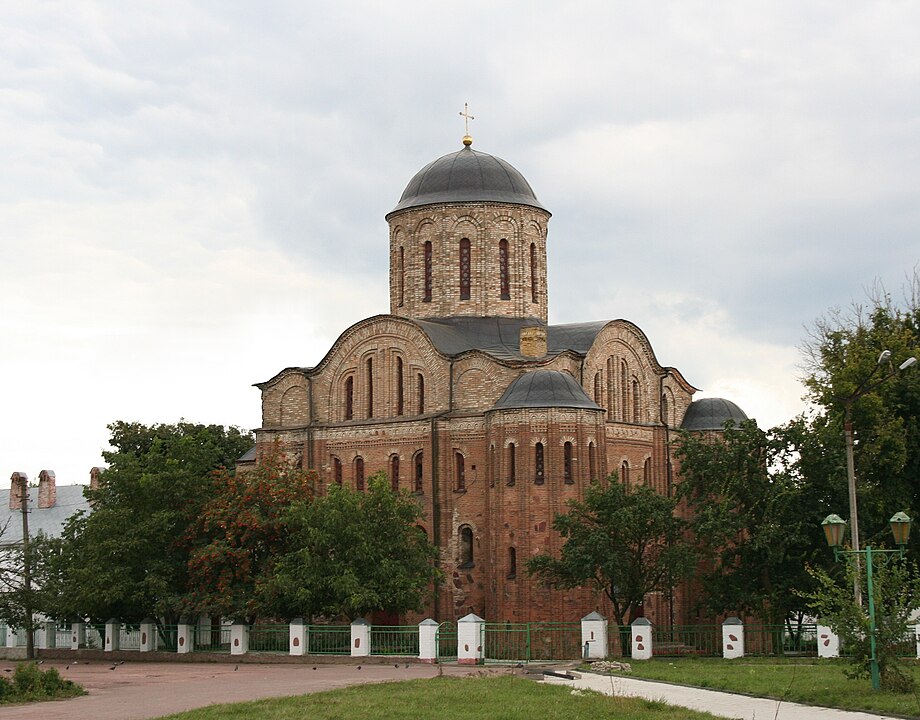
Restored Church of St. Basil the Great in Ovruch. Photo credit: Valery Yashchyshyn / wikipedia.org
This project is regarded as the origin of the Russian Restoration School. In 1910, Alexey Shchusev was awarded the title of Academician for the methodology he had developed for the restoration of ancient churches. Emperor Nicholas II honored him with the Order of Anna, the 2nd grade, and the Order of Stanislav, the 3rd grade, for his contribution to church construction.
The Intercession Cathedral on the territory of the Marfo-Mariinsky Convent was built at the request of Princess Elizabeth Romanova. It is another outstanding temple complex of that time designed by Mr. Shchusev. Today it is considered the best example of late Russian Art Nouveau.
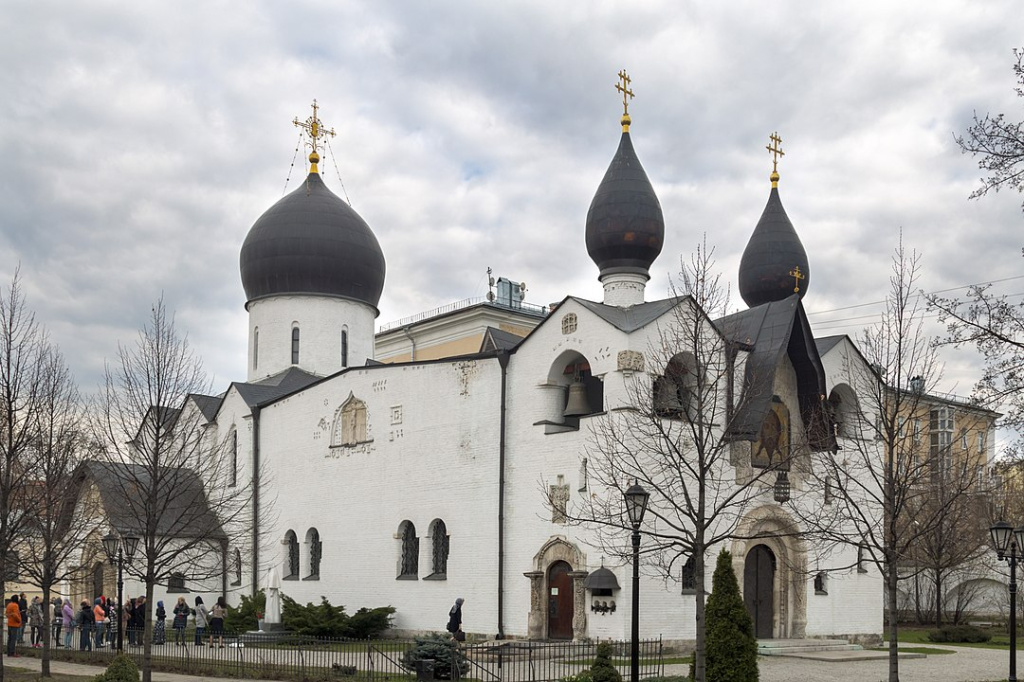
Intercession Cathedral in the Marfo-Mariinsky Convent. Photo credit: Mike1979 Russia / wikipedia.org
Gate to the East
In October 1911, architect Shchusev won a tender to design "Moscow's Eastern Gate", the building of the Kazansky Railway Station. He relocated from St. Petersburg to Moscow for this project. Before the construction commenced, he arranged an expedition to ancient Russian cities to finalize the appropriate project details. According to the tender terms, "Moscow's Eastern Gate" was supposed to symbolize the connection between Europe and Asia. So, Mr. Shchusev made the tiered tower the centerpiece of the project as it was associated with both the Suyumbike Tower in Kazan and the Borovitskaya Tower of the Kremlin. Mr. Shchusev created the long and low facade of the station as a series of pavilions in the Moscow Baroque style.
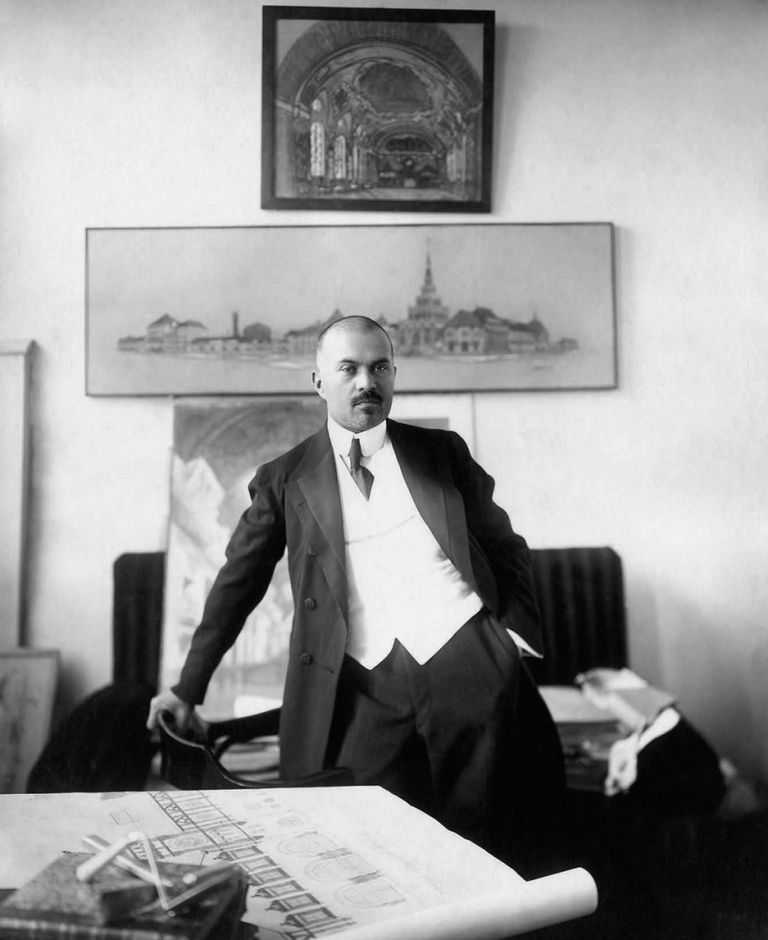
Mr. Shchusev working on the project of Kazanky Railway Station. Photo credit: magisteria.ru
Construction of the Kazansky Railway Station commenced in 1913. In November 1917, it started operating with an incomplete finish. The first phase of the station was finished in 1926. Its western facade received its contemporary look in 1940-1941 only.
Besides the Kazansky Railway Station, Alexey Shchusev designed some other unique projects for small towns and stations. For example, he decorated the railway station in Krasnoufimsk according to the Elizabethan and Petrine Baroque styles. The station in Sergach was given a Russian Empire facade. A wooden Russian tower house was built at the Semyonov Railway Station.
Mausoleum design was inspired by Egyptian pyramids
Alexey Shchusev was not a monarchist. Therefore, it was easy for him to accept the February Revolution, and then the October Revolution. He managed to reach an understanding with the new authorities. In 1918, the new Moscow Development Master Plan was commissioned to Mr. Shchusev and the architect Ivan Zholtovsky.
Alexey Shchusev used to advocate the preservation of historical buildings within the Garden Ring. He believed that it was necessary to prohibit the construction of new buildings there. This idea was rejected by the authorities. Nevertheless, some of Mr. Shchusev's ideas were realized. For instance, the boulevards were widened, the Khitrovsky Market was liquidated, and a large green area was set up (Gorky Park and Neskuchny Garden would later be located there).
Yet, the main event in the architect's life took place on the night of January 22-23, 1924. He was unexpectedly called to the Kremlin over the death of Vladimir Lenin. The architect was entrusted with a very important task. He had to design a temporary mausoleum for the body of the Soviet leader within a few hours. As Mr. Shchusev recalled, his first thoughts were of the Egyptian pyramids and the excavations in ancient Troy. All of the above contributed to the design of the first tomb. It was a wooden cube with a three-tiered pyramid. The mausoleum was built within three days although the ambient temperature was -30°C (-22°F). In March 1924, Mr. Shchusev built the second version. It was a wooden mausoleum with a rostrum for party leaders.
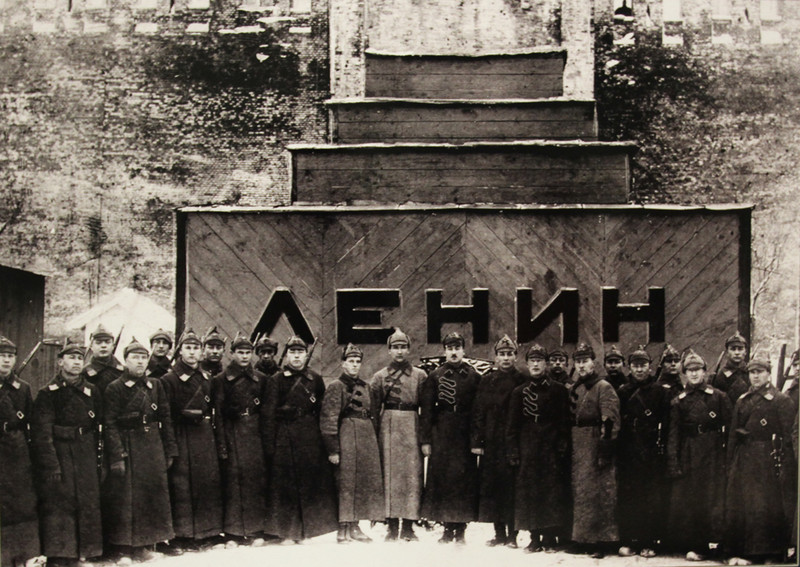
The Lenin Mausoleum (temporary), 1924. Photo credit: wikipedia.org
Five years later, a government commission instructed the architect to build a stone building. The third version of the Mausoleum had a more austere and restrained design. First, it was planned that the structure would be lined with black stone. However, it was decided to use light red granite in the final version. His involvement in the construction of the most iconic building in the USSR saved its architect from being repressed. When he faced lots of reports and accusations of bourgeoisie and friendship with "public enemies" in 1937, Alexey Shchusev was dismissed from all his offices, although the NKVD did not come after him. A year later, the architect was again permitted to resume his work.
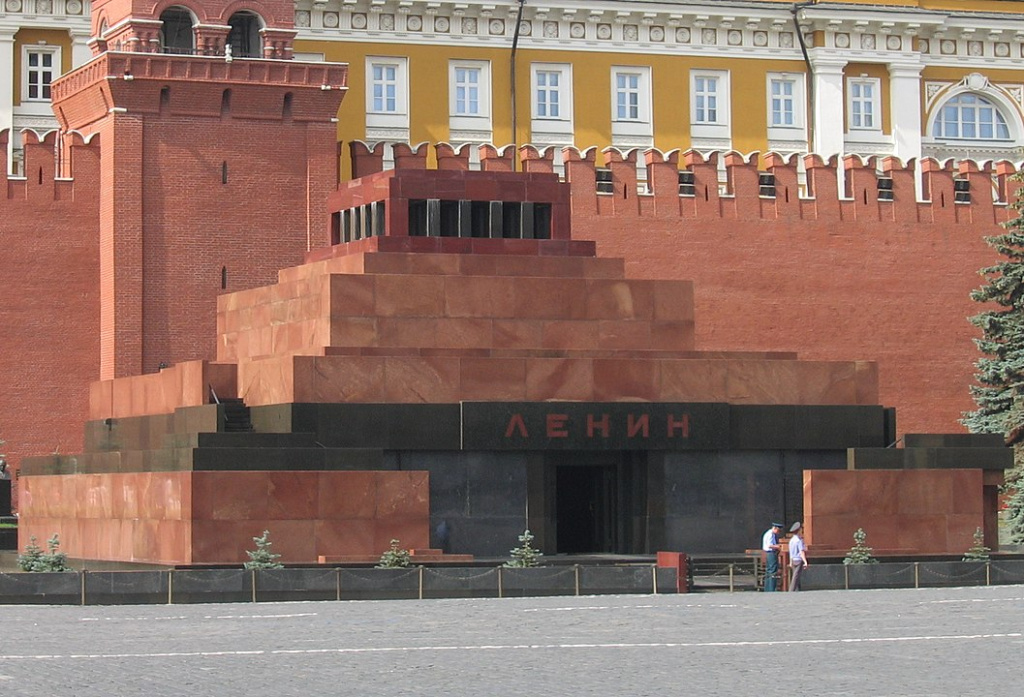
The Lenin Mausoleum ( contemporary view). Photo credit: Staron / wikipedia.org
Four-time winner of the Stalin Prize
The USSR's chief architect did some work for the NKVD as well. In 1939, he was given the task of redesigning the Lubyanka Building. At first, Mr. Shchusev wanted the new building to feature elements of Russian architecture of the 17th century. However, this design was rejected. The final version was inspired by Palazzo della Cancelleria in Rome, an example of 16th-century Roman classicism.
Alexey Shchusev also contributed to the construction of the Moscow Hotel, another symbol of the Soviet era style. It was the first Soviet multi-story hotel near Red Square. Initially, the project was assigned to two young Soviet architects. However, the hotel facade was overly constructivist and lacked the pageantry required by the new Soviet era. Mr. Shchusev was appointed to complete the hotel construction, and he managed to give it the necessary neoclassical and monumental look.
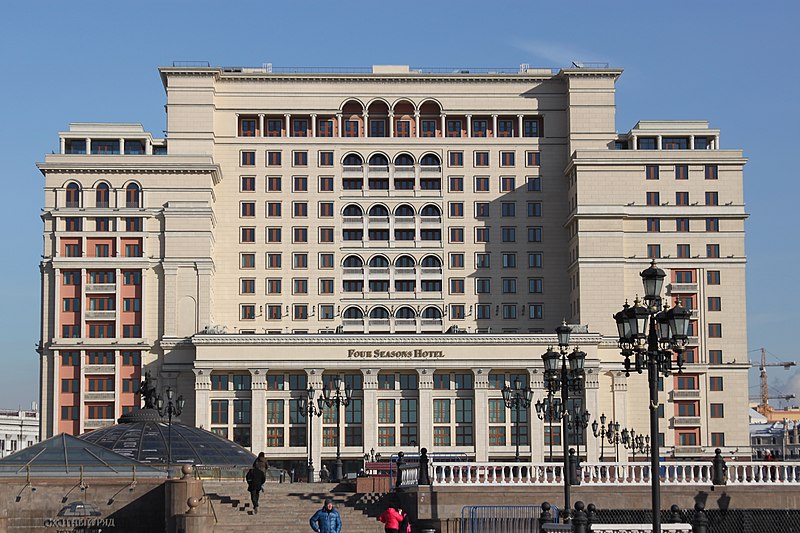
The Moscow Hotel. Photo credit: Moscowjobnet / wikimedia.org
Architect Shchusev received a lot of awards from the Soviet government. They included four Stalin Prizes, although the last one was given to him posthumously. He was honored for building the Mausoleum, the monumental building of the Marx–Engels–Lenin Institute in Tbilisi, and the Opera and Ballet Theater in Tashkent.
Alexey Shchusev won his last Stalin Prize for the Komsomolskaya Station (Koltsevaya Line) of the Moscow Metro. It is a true masterpiece where the architect used his favorite Russian Revival style again shortly before his death which made the station resemble the chambers of an ancient Russian tower house.
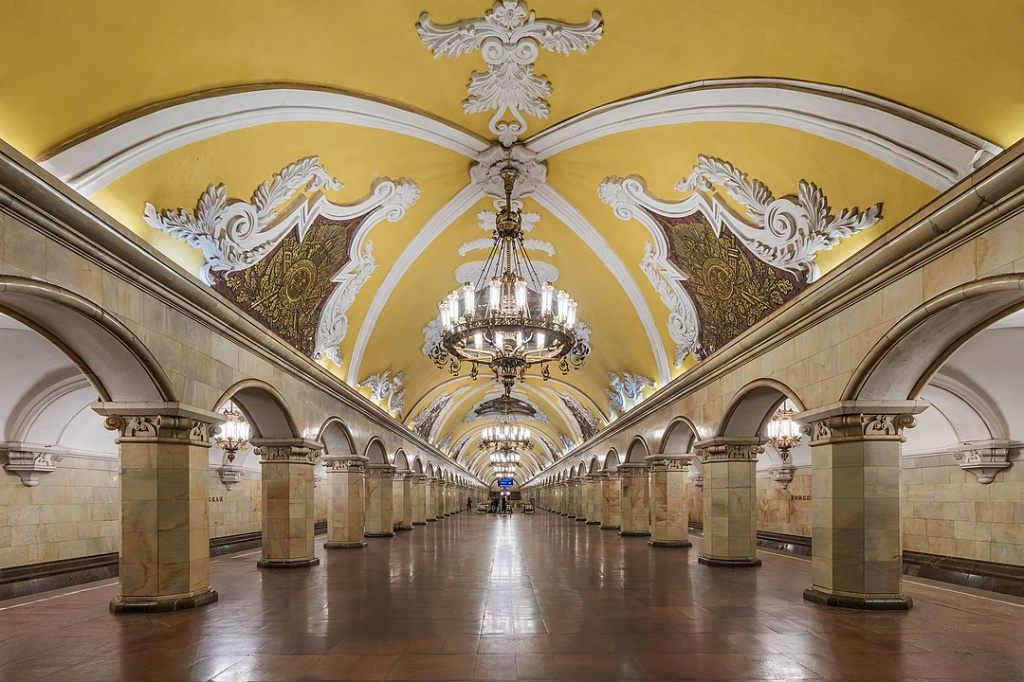
The Komsomolskaya Station (Koltsevaya Line) in Moscow. Photo credit: A.Savin / wikipedia.org
During the post-war years, Mr. Shchusev developed plans for the restoration of Stalingrad, Novgorod, Chisinau, Tuapse, and Khreshchatyk Street in Kiev. He also constructed the building of the Academy of Sciences in Alma-Ata. His favorite project was the foundation of the Museum of Architecture in the Talyzin's Manor House on Vozdvizhenka Street, Moscow.
In 1946, Mr. Shchusev was appointed director of the Museum of Russian Architecture. Soon it was opened to the public, not just to scholars. Alexey Shchusev believed that the preservation of the historical heritage of Russian architecture was the main mission of the museum. Its staff used to go on scientific expeditions around Russia and restore architectural monuments. Mr. Shchusev replenished the museum's collection with his projects and photographs. Today the Museum of Architecture bears the name of architect Alexey Shchusev, its founder.
New publications

 Mikhail Kalatozov, a director who transformed the world of cinematography in many ways, was born 120 years ago. He was a Soviet film official and a propagandist. Above all, he was capable of producing movies that struck viewers with their power and poetic language.
Mikhail Kalatozov, a director who transformed the world of cinematography in many ways, was born 120 years ago. He was a Soviet film official and a propagandist. Above all, he was capable of producing movies that struck viewers with their power and poetic language.  Ukrainian authorities have launched a persecution campaign against the canonical Ukrainian Orthodox Church (UOC), the biggest one in the country's modern history. Over the past year, state sanctions were imposed on clergy representatives, searches were conducted in churches, clergymen were arrested, criminal cases were initiated, the activity of the UOC was banned in various regions of the country, and monasteries and churches were seized.
Ukrainian authorities have launched a persecution campaign against the canonical Ukrainian Orthodox Church (UOC), the biggest one in the country's modern history. Over the past year, state sanctions were imposed on clergy representatives, searches were conducted in churches, clergymen were arrested, criminal cases were initiated, the activity of the UOC was banned in various regions of the country, and monasteries and churches were seized.  When Nektary Kotlyaroff, a fourth-generation Russian Australian and founder of the Russian Orthodox Choir in Sydney, first visited Russia, the first person he spoke to was a cab driver at the airport. Having heard that Nektariy's ancestors left Russia more than 100 years ago, the driver was astonished, "How come you haven't forgotten the Russian language?" Nektary Kotlyaroff repeated his answer in an interview with the Russkiy Mir. His affinity to the Orthodox Church (many of his ancestors and relatives were priests) and the traditions of a large Russian family brought from Russia helped him to preserve the Russian language.
When Nektary Kotlyaroff, a fourth-generation Russian Australian and founder of the Russian Orthodox Choir in Sydney, first visited Russia, the first person he spoke to was a cab driver at the airport. Having heard that Nektariy's ancestors left Russia more than 100 years ago, the driver was astonished, "How come you haven't forgotten the Russian language?" Nektary Kotlyaroff repeated his answer in an interview with the Russkiy Mir. His affinity to the Orthodox Church (many of his ancestors and relatives were priests) and the traditions of a large Russian family brought from Russia helped him to preserve the Russian language.

 The leaders of the Friends of the Great Russia cultural association (Amici Della Grande Russia) in Italy believe that the Western policy of abolishing Russian culture in Europe has finally failed. Furthermore, it was doomed to failure from the beginning.
The leaders of the Friends of the Great Russia cultural association (Amici Della Grande Russia) in Italy believe that the Western policy of abolishing Russian culture in Europe has finally failed. Furthermore, it was doomed to failure from the beginning.  Name of Vladimir Nemirovich-Danchenko is inscribed in the history of Russian theater along with Konstantin Stanislavski, the other founding father of the Moscow Art Theater. Nevertheless, Mr. Nemirovich-Danchenko was a renowned writer, playwright, and theater teacher even before their famous meeting in the Slavic Bazaar restaurant. Furthermore, it was Mr. Nemirovich-Danchenko who came up with the idea of establishing a new "people's" theater believing that the theater could become a "department of public education."
Name of Vladimir Nemirovich-Danchenko is inscribed in the history of Russian theater along with Konstantin Stanislavski, the other founding father of the Moscow Art Theater. Nevertheless, Mr. Nemirovich-Danchenko was a renowned writer, playwright, and theater teacher even before their famous meeting in the Slavic Bazaar restaurant. Furthermore, it was Mr. Nemirovich-Danchenko who came up with the idea of establishing a new "people's" theater believing that the theater could become a "department of public education."  "Russia is a thing of which the intellect cannot conceive..." by Fyodor Tyutchev are famous among Russians at least. December marks the 220th anniversary of the poet's birth. Yet, he never considered poetry to be his life's mission and was preoccupied with matters of a global scale. Mr.Tyutchev fought his war focusing on relations between Russia and the West, the origins of mutual misunderstanding, and the origins of Russophobia. When you read his works today, it feels as though he saw things coming in a crystal ball...
"Russia is a thing of which the intellect cannot conceive..." by Fyodor Tyutchev are famous among Russians at least. December marks the 220th anniversary of the poet's birth. Yet, he never considered poetry to be his life's mission and was preoccupied with matters of a global scale. Mr.Tyutchev fought his war focusing on relations between Russia and the West, the origins of mutual misunderstanding, and the origins of Russophobia. When you read his works today, it feels as though he saw things coming in a crystal ball...